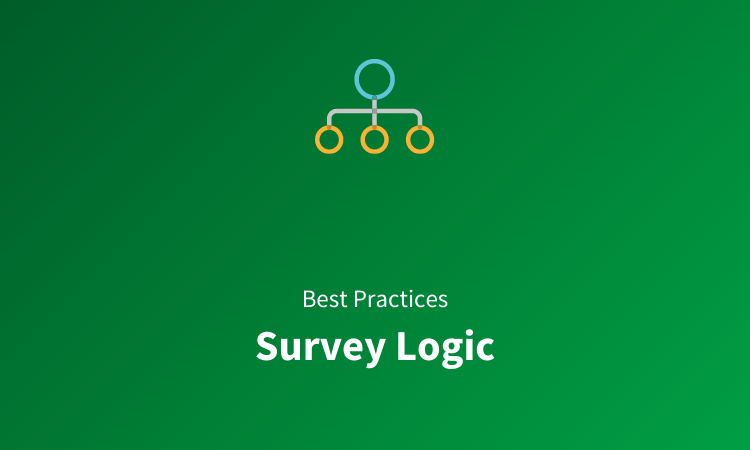Designing a survey is an interesting task for the survey researchers. But at the same time it can become confusing as you not only have to decide on the questions to be asked, but also design the questionnaire in such an order where the questions seem logical and appropriate to be asked.
Imagine you are filling a Customer Feedback Survey and you get a question, "Do you like this product?" (Options: Yes, No, Neither Like nor Dislike)
You respond "No".
And then the next question appears, "What did you like the most about this product?"
How would you feel the survey is? Typically illogical, isn't it! Do you want your customers to feel like this while providing you feedback? I'm sure you don't. Here comes the need of Survey Logic. Let's understand what survey logic is and how it works to make your surveys better and logical.
What is Survey Logic?
Survey Logic is a feature that changes the behavior, appearance and content of the surveys according to the answers provided by the respondents. It is also known as Skip Logic as it enables you to design your surveys in a way where you can skip your respondents to the next part of the survey.
Basically, it skips that part of the survey which are not relevant to them and are directly moved to that part of the survey which is relevant for them.
Survey Logic may seem to be a good additional feature to be used when needed, but in reality it is a necessary feature which your Survey Software must have if you want to create effective surveys. Lets' understand why Survey Logic is necessary for creating surveys effectively by exploring some benefits of using survey logic.
Benefits of Using Survey Logic
- It actually makes the survey logical
- It gives a feeling of personalization
- It helps to reduce survey filling time
- It helps to reduce survey dropouts
- It increases accuracy of the survey results
Let's understand how Survey Logic helps to make your surveys successful by providing these benefits.
1. It actually makes the Survey Logical
As the name suggests, 'Survey Logic' makes your surveys logical to read and fill. Imagine you filling a feedback form of a retail store where you are asked "Have you tried our new range of T-shirts?" You reply "No". How would you feel if the next question comes "How would you rate the quality of our new range of T-shirts". Obviously it doesn't make sense to rate the quality of a product which you haven't tried yet.
Survey Logic helps to avoid such blunders by taking your customers to the questions which are relevant for them according to the answers they provide.
2. It gives a feeling of Personalization
Survey Logic helps to customize your surveys as per the answers provided by the customers. This gives a feeling of personalization to your customers which is itself a boom for your business because 80% of customers are more likely to purchase products or services from brands that provide personalized experiences.
3. It helps to reduce survey filling time
Survey Logic helps to reduce the time taken by the customers to fill the survey because it eliminates all the irrelevant questions which would otherwise waste a lot of time of your customers.
4. It helps to reduce survey dropouts
When the customers face irrelevant questions while filling a survey, they get confused about what should they answer. This makes them feel agitated and they tend to leave the survey in between. Whereas, if survey logic is used and they are asked only the questions relevant for them, they fill the survey easily and quickly. This reduces the survey dropouts which makes your surveys successful.
5. It increases accuracy of the survey results
If you do not use survey logic and ask irrelevant questions from the the customers, either they will leave the survey in between or they will select any inaccurate option just for the sake of completing the survey. This can adversely affect the accuracy of the survey as the data you get through it is not true.
When you use Survey Logic, the customers get logical and relevant questions for which they provide true and accurate answers to the best of their knowledge. This helps to increase the accuracy of your surveys.
After understanding what survey logic is and how it is beneficial for your surveys, let's move to the Best Practices you must follow while using Survey Logic.
Best Practices for using Survey Logic
- Use Logics for only forward questions
- Use one logic per page
- Don’t add too many logics in a survey
- Don’t add Hide and Skip Logic together
- Make Survey Logic very relevant
- Test thoroughly all the conditions
Let's learn how these tips help you to use Survey Logic effectively and create effective surveys.
TIP 1
Use Logics for only forward questions
The Survey Logic should only be for forward questions and not the backward questions. This means you should not move your customers to the backward pages, they must move forward by selecting an answer in your surveys.
In the case of backward movement, the customers may get struck in the survey in the circular loop and would not be able to complete the survey. Ensure that the answer given by the customers let's say on page 3 of the survey should go to page 5 or 6 when used skip logic, not back to page 1 or 2.
In Zonka Feedback, by default, we don't have the option to create logic that takes you to a previous question instead of forward.
TIP 2
Use one logic per page
You may think to provide your short survey in a single page so that the customers can quickly fill it and complete the survey, but when you are using Survey Logic, it is always advised to use more pages. You must not include more than one logic on one page.
Reason is simple, you can only use skip logic on the last question of the page. If you apply it in between, how will the next questions change? For instance, you use 4 questions in a survey and there is a need of survey logic after the second question. How will it work if the third question doesn't change or skipped?
And what will be the benefit of a survey logic if the customers have to answer that third question which is absolutely irrelevant for them. So always use only one logic on one page.
While at Zonka Feedback, you can add multiple logics per page, we advise against it.
TIP 3
Don’t add too many logics in a survey
Although Skip Logic is a great and important feature, still we will advice not to overuse it. Add only a few logics which are necessary and can actually help to make the survey logic with a touch of personalization.
TIP 4
Don’t add Hide and Skip Logic together
Skip Logic is added to skip a screen or multiple screens based on a choice made in the question. Hide Logic is to hide screens (which may or may not be) adjacent to the current screen, based on the specific responses of the respondents.
Hide logic works on the criteria you have set to be met by the respondents or their responses for the screen to be displayed. Prefer not to use hide logic and skip logic together, you should use either of the two.
TIP 5
Make Survey Logic very relevant
When you use Survey Logic, you should not use it just for the sake of using it. Make sure that the logic you are using is very relevant and makes sense. Imagine you filling a Restaurant Feedback Survey that is asking you "Have you tasted our newly launched range of pizzas?" You reply "Yes" and the survey takes you to page which starts asking experience about new range of ice-creams instead of pizzas.
This will make the survey irrelevant and will defeat the entire purpose of using a Survey Logic. So always take care of such things and ensure that the survey logic you are using is working properly.
TIP 6
Test thoroughly - all the conditions
Last but not the least, always test your survey thoroughly after applying survey logic and before sending it to your customers. Do preview your surveys and fill the survey forms exactly like your customers will do, so that if there is any mistake or any logic wrongly placed, you get to know it on time and can rectify it.





 iPad Surveys
iPad Surveys Android Surveys
Android Surveys Kiosk Surveys
Kiosk Surveys Mobile Forms
Mobile Forms Email Surveys
Email Surveys SMS Surveys
SMS Surveys Website Surveys
Website Surveys Creating Surveys
Creating Surveys Multilingual Surveys
Multilingual Surveys Collecting Feedback
Collecting Feedback Closing Feedback Loop
Closing Feedback Loop Reporting & Analytics
Reporting & Analytics NPS Dashboard & Reporting
NPS Dashboard & Reporting Multiple Locations & Chains
Multiple Locations & Chains Offline Device Tracking
Offline Device Tracking APIs, Webhooks & Integrations
APIs, Webhooks & Integrations Healthcare
Healthcare Education
Education Retail
Retail Financial
Financial Restaurants
Restaurants Hotels
Hotels Customer Satisfaction
Customer Satisfaction Patient Satisfaction
Patient Satisfaction Employee Satisfaction
Employee Satisfaction Net Promoter Score
Net Promoter Score Website Surveys
Website Surveys Feedback Form Templates
Feedback Form Templates Integrations
Integrations The Ultimate NPS Guide
The Ultimate NPS Guide Survey Tips and Tricks
Survey Tips and Tricks Blog and Insights
Blog and Insights Survey Guides
Survey Guides Help Documentation
Help Documentation Customers
Customers

















